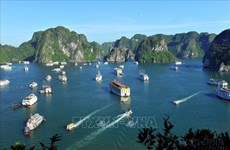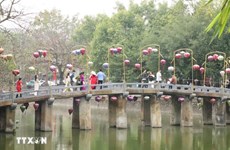National park draws anglers to wetland fisherman's paradise
Every weekend, hundreds of people flock to the U Minh Thuong National
Park in the southern province of Kien Giang to fish as a leisure
activity. Here there are different kinds of huge fish far beyond their
wildest dreams.
Every weekend, hundreds of people flock to the U Minh Thuong National
Park in the southern province of Kien Giang to fish as a leisure
activity. Here there are different kinds of huge fish far beyond their
wildest dreams.
That's why it's not rare to find a long line of cars queuing up along the road that leads to the park. Most of the vehicles have travelled from HCM City , 365km away.
For many people, fishing in this remote area is a way to escape from the bustle of city life and enjoy the primitive cajuput forest, where they are greeted by bird songs and insect chirps.
Proclaimed a National Park in 2002, U Minh Thuong covers a 22,918ha area of freshwater wetlands, peat forest, seasonally inundated grassland and swamp. The core zone of the park is surrounded by a canal and dyke system, creating an ideal environment for aquatic species.
One of the last significant peat forests remaining in Vietnam , the park has also been recognised as one of the three highest priority sites for wetland conservation in the Cuu Long ( Mekong ) Delta.
U Minh Thuong is home to more than 250 and 500 species of plants and animals, respectively. Nine species of bird living in the park have been listed in the Red Book: the oriental darter, spot-billed pelican, painted stork, lesser adjutant, black-headed ibis, glossy ibis, greater spotted eagle, grey-headed fish eagle, and the Asian golden weaver. In addition, at least eight species of economically valuable fish have been found at this park.
In order to maintain the natural environment, tourists are allowed to travel only within a 500ha area of the park's central zone.
When fishing, most of the tourists use the humble cajuput-wooden tents scattered by Hoa Mai Lake . The lake is considered to be the "tourist centre" of the park because it is the only place in the area offering catering and other basic services.
Visitors pay 40,000 VND for admission to the fishing grounds, with a rod and bait included in the price.
Professional fishermen prefer to hire a wooden motor boat for 30,000 VND per person to go deeper into the forest, where they can catch much bigger fish.
However, due to the limited number of service boats, tourists have been encouraged to book them in advance through the park's management board.
While the boats glide along the water, visitors may have surprise encounters with the thousands of bats that hang themselves on tree branches. If they are lucky they may even see monkeys, who then quickly flee deep into the jungle at the first sign of humans.
"I often spend my weekends going fishing here together with my family and friends. The feeling of being in nature is amazing. More importantly, that feeling can help refresh me after a long, hard week of working," said HCM City visitor Le Cong Thanh.
Nguyen Van Minh, another regular visitor of the park, equips himself with all the necessary items whenever he goes fishing: a modern rod, different kinds of bait for various species of fish, a palm-leave conical hat, a raincoat, plastic boots and food.
According to him, the swamp is a perfect place for fishing because the aquatic plants are home to many fish.
For many tourists, it is ideal to have a meal prepared with fresh fish and other local indigenous vegetables right on the spot, and then lie down on a hammock to enjoy the forest's tranquillity.
Non-fishing tourists can climb to one of the several watchtowers and enjoy a panoramic view of the reserve. An immense green zone stretches as far as the eye can see, and the harmonic melody created by the sound of the wind blowing and birds singing can purify the spirit of any visitor.
Unlike Minh, who goes fishing alone, Anh Nguyen and his friends gather into an eight-member group.
"We share a rental car from HCM City to the park. It's much more fun when you have companions, who also have the same hobby," he explained.
His group has travelled to different regions in the south to fish but he said they've never seen so many fish as in U Minh Thuong. "Each one of us catches at least 6-7kg of snakefish whenever we go fishing at the park."
According to the park's chief tourist manager, Nguyen Van Nhien, since the park opened to tourists in 2004, the number of visitors has increased every year.
Now, an average of 2,000 tourists visit the park every month, promoting the eco-friendly development of the region. /.
That's why it's not rare to find a long line of cars queuing up along the road that leads to the park. Most of the vehicles have travelled from HCM City , 365km away.
For many people, fishing in this remote area is a way to escape from the bustle of city life and enjoy the primitive cajuput forest, where they are greeted by bird songs and insect chirps.
Proclaimed a National Park in 2002, U Minh Thuong covers a 22,918ha area of freshwater wetlands, peat forest, seasonally inundated grassland and swamp. The core zone of the park is surrounded by a canal and dyke system, creating an ideal environment for aquatic species.
One of the last significant peat forests remaining in Vietnam , the park has also been recognised as one of the three highest priority sites for wetland conservation in the Cuu Long ( Mekong ) Delta.
U Minh Thuong is home to more than 250 and 500 species of plants and animals, respectively. Nine species of bird living in the park have been listed in the Red Book: the oriental darter, spot-billed pelican, painted stork, lesser adjutant, black-headed ibis, glossy ibis, greater spotted eagle, grey-headed fish eagle, and the Asian golden weaver. In addition, at least eight species of economically valuable fish have been found at this park.
In order to maintain the natural environment, tourists are allowed to travel only within a 500ha area of the park's central zone.
When fishing, most of the tourists use the humble cajuput-wooden tents scattered by Hoa Mai Lake . The lake is considered to be the "tourist centre" of the park because it is the only place in the area offering catering and other basic services.
Visitors pay 40,000 VND for admission to the fishing grounds, with a rod and bait included in the price.
Professional fishermen prefer to hire a wooden motor boat for 30,000 VND per person to go deeper into the forest, where they can catch much bigger fish.
However, due to the limited number of service boats, tourists have been encouraged to book them in advance through the park's management board.
While the boats glide along the water, visitors may have surprise encounters with the thousands of bats that hang themselves on tree branches. If they are lucky they may even see monkeys, who then quickly flee deep into the jungle at the first sign of humans.
"I often spend my weekends going fishing here together with my family and friends. The feeling of being in nature is amazing. More importantly, that feeling can help refresh me after a long, hard week of working," said HCM City visitor Le Cong Thanh.
Nguyen Van Minh, another regular visitor of the park, equips himself with all the necessary items whenever he goes fishing: a modern rod, different kinds of bait for various species of fish, a palm-leave conical hat, a raincoat, plastic boots and food.
According to him, the swamp is a perfect place for fishing because the aquatic plants are home to many fish.
For many tourists, it is ideal to have a meal prepared with fresh fish and other local indigenous vegetables right on the spot, and then lie down on a hammock to enjoy the forest's tranquillity.
Non-fishing tourists can climb to one of the several watchtowers and enjoy a panoramic view of the reserve. An immense green zone stretches as far as the eye can see, and the harmonic melody created by the sound of the wind blowing and birds singing can purify the spirit of any visitor.
Unlike Minh, who goes fishing alone, Anh Nguyen and his friends gather into an eight-member group.
"We share a rental car from HCM City to the park. It's much more fun when you have companions, who also have the same hobby," he explained.
His group has travelled to different regions in the south to fish but he said they've never seen so many fish as in U Minh Thuong. "Each one of us catches at least 6-7kg of snakefish whenever we go fishing at the park."
According to the park's chief tourist manager, Nguyen Van Nhien, since the park opened to tourists in 2004, the number of visitors has increased every year.
Now, an average of 2,000 tourists visit the park every month, promoting the eco-friendly development of the region. /.










